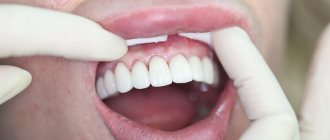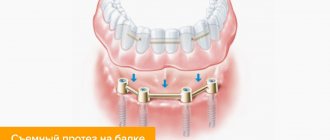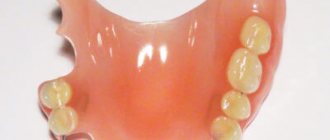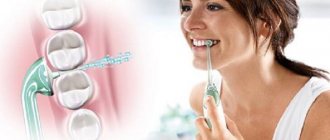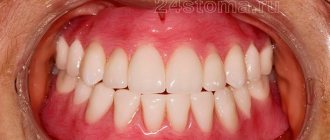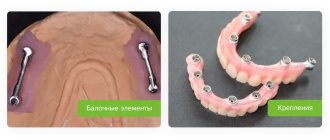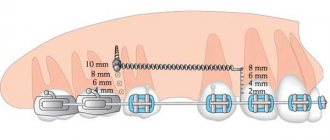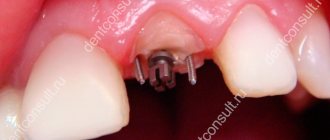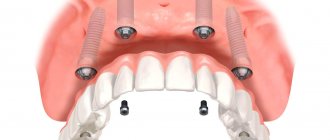There are many options for rehabilitation of patients with complete absence of teeth, both with and without the use of implants. Partially, we touched on this topic in this article, and today we will take a closer look at the existing methods of prosthetics for edentulous jaws supported by implants, talk about the indications and contraindications of various prosthetic plans and discuss the differences between them.
Unlike other clinical situations, the absence of teeth in the jaw provides quite a wide scope for creativity.
We see many solutions offered by various clinics. In general terms, as mentioned earlier, it can be divided into removable and non-removable. In turn, removable prosthetics is divided into two types, locking fixation of a removable prosthesis on special abutments and the use of a special beam (or beams) to support it :
“Lock fixation of a removable denture” , which is implemented in two ways: with special ball abutments or the so-called. “locators”:
We have been seeing patients with similar structures for more than 10 years. For example, the treatment described in the pictures above has a continuation:
As you can see, the treatment in this case did not go smoothly. Therefore, no matter how attractive the use of two implants may seem to fix existing removable dentures, this is still a temporary solution that inevitably promises problems in the long term.
Therefore, we use it extremely rarely, almost always as a temporary support
It can be used permanently only in the following cases:
– when the patient’s age is 75 years or older.
– when the experience of using removable dentures is more than 10-15 years
– when the antagonist is also a removable denture
Fulfillment of these conditions is a guarantee that no load will be applied to the implants, locks and the prosthesis itself, which could ruin everything. At the same time, this is a low-traumatic solution that at least slightly improves the quality of life for patients who have to use special glue, such as Corega, to fix removable dentures.
No matter how wonderful this solution may be, no matter how simple and cheap it may seem, we do not recommend using it as a permanent solution in all other clinical situations , such as:
– age under 70 years
– no experience in using complete removable dentures
– antagonists are fixed prosthetic structures supported by natural teeth and/or implants
– with muscle-joint dysfunction, especially accompanied by bruxism.
– with rapid, very rapid loss of teeth, for example, as a result of progressive periodontitis.
In all these cases, it is better to consider another rehabilitation option.
Choice according to indications and budget
The best dentures are those that are indicated for the patient. Generally speaking, the most modern designs will be those based on implants. However, there are two very important points here: implantation has a number of limitations and is considered an expensive procedure (especially if we are talking about complete dental restoration). In this case, other structures come to the rescue, which are also designed to restore chewing function and aesthetics. Before we start talking about the different systems in more detail, we need to make some distinctions so that you don't get confused.
All dentures are usually divided into several types. First of all, the number of teeth being replaced is taken into account: this criterion implies the installation of a partial or complete denture. According to the method of fixation of the structure in the oral cavity, removable, conditionally removable and fixed dentures are distinguished. Which ones are better - read on.
Cost of removable structures
Each removable denture is custom-made to precisely fit the anatomical features of the mouth and jaw. Its cost depends on the complexity of production and the selected materials.
Plastic and acrylic types of prostheses are very popular with patients, as they are the least expensive for patients. Nylon and clasp varieties are much more expensive. Moreover, for the quality of such work, neither price nor size has any advantages, since all removable dentures are a temporary solution and are not suitable for all patients. In any case, each type of removable prosthesis is inferior to a fixed prosthesis in terms of functional and external characteristics.
Which denture is best for missing teeth?
Previously, patients who, for one reason or another, were unable to have implants installed, had to put up with rather uncomfortable prostheses made of hard plastic. Today there are modern designs on the market that cause virtually no inconvenience to their owner. Many are also looking for the best removable dentures for the upper jaw, since it is when restoring teeth in the upper jaw that good fixation of the structure is especially important so that the denture does not fall out in the most unexpected cases. Installation of a high-quality fixed (conditionally removable) complete denture is not complete without implantation.
Bridge prosthesis on implants
When several teeth are missing in a row, implant-supported dentures are the ideal choice. As a rule, 2 implants are installed, onto which a prosthesis imitating the crown part of the tooth is subsequently fixed.
Classic bridges
Fixed structures that replace a fragment of the dentition and are installed on adjacent ground teeth. The most modern bridges are usually made of ceramic and look more aesthetically pleasing than their metal counterparts.
Butterfly prosthesis
So named because of its shape, which resembles the wings of insects. Allows you to replace up to three missing teeth in a row. A plastic butterfly prosthesis imitates the crown of a tooth and part of the gum, attached to adjacent teeth using clasps. Application is justified as a temporary measure.
Clasp dentures
The best dentures of this type are considered to be structures made of nylon and acrylic, imitating part of the dentition on both sides of the jaw. There are designs with metal arches and with metal fixing elements (clasps), the disadvantages of which are allergic reactions, injury to one’s own supporting teeth and aesthetics.
Complete denture on implants with bar fixation
It is considered one of the best options for a complete denture on implants, since the load is distributed evenly across the entire beam and high stability of the entire structure is achieved.
Complete denture on implants with ball-shaped fixation
A spherical abutment is installed on each implant, which is fixed to the prosthesis using special locks. It is also considered an excellent option, but is slightly inferior to beam structures in terms of reliability.
Removable denture on mini-implants
Mini-implants are also installed into the bone, so the volume of bone tissue is just as important here as when installing standard implants. In this case, only removable structures are suitable for prosthetics, since mini-implants are used as a temporary option and cannot bear a more serious, permanent load.
Complete removable plate denture
Removable complete dentures completely model the jaw and palate. Today there are many models on the market, but the latest generation of acrylic and nylon prostheses are considered the most modern.
Contraindications
Installation of beam prostheses is impossible in the following conditions:
- the presence of caries, active inflammatory processes, and other oral diseases;
- atrophy of bone tissue at the sites of implantation;
- with diagnosed bruxism;
- with low blood clotting, the presence of autoimmune diseases;
- Beam prosthetics is not recommended during pregnancy, breastfeeding, or taking a certain list of medications.
Which material is better and will last longer?
The material from which the prosthesis is made has the greatest impact on wearing comfort, and this is especially true for removable structures. If no errors were made during the manufacture of the structure itself, but the prosthesis still causes significant discomfort, then the problem is most likely due to the poor quality of the material. Of course, no such design can provide 100% convenience (especially at the adaptation stage), but modern materials make it possible to achieve very high performance. So, what qualities should the best materials for dentures have:
- Hypoallergenic.
Many people are allergic to dyes and acrylates. - "Friendly" to gums.
If the denture rubs the gums a lot, wearing it will be a complete torture. - Color fastness.
Immunity to staining and environmental influences. - Acceptable strength.
Despite the fact that a removable denture rarely lasts more than 5–6 years, the structure should not be overly fragile.
If we talk about specific brands of removable dentures, the best lamellar denture is considered to be Acry-Free (“Acry-Free”) made of acrylic-free plastic: it is very comfortable, does not shrink when worn, does not stain and does not cause allergies. The best nylon dentures at the moment are Quadrotti. However, they have limitations for use: to install such a prosthesis, one of the jaws must have several healthy teeth, however, like other clasp-type prostheses. As for non-removable systems, metal-free structures are increasingly being used, which look more aesthetically pleasing, do not cause allergies, but are no less durable.
Before and after installation of dentures. Works by P. A. Zotov
What happens if you don't restore a missing tooth for a long time?
- The teeth adjacent to the lost “fighter” will begin to shift and tilt towards the void.
- The antagonist tooth, the one that was opposite the removed one, will try to “find” its brother and move out of its dentition towards, occupying the resulting void.
- The balance of uniform distribution of the chewing load on all teeth will be disrupted; even if the bite was initially good, it will begin to deteriorate.
- Periodontal (gum) diseases, headaches and a crunch in the jaw will appear (the upper mandibular joint (TMJ) will begin to work incorrectly)
Such problems concern all patients who have lost teeth, and of any age. What to do? There is only one way out - to get prosthetics in time. There are many methods - you just need to choose the one that suits you.
Read about various prosthetic methods in our articles:
Fixed prosthetics
Removable prosthetics
Prosthetics on implants.
How much do the best dentures cost?
| Construction type | Price |
| Crowns | From 12,000 rubles for metal ceramics to 40,000 for zirconium crowns |
| Veneers | 20,000 – 55,000 rubles per unit |
| Partial denture on implants | From 70,000 rubles |
| Classic bridge | On average 8,000 – 15,000 rubles |
| Complete denture on implants | 150,000 – 600,000 rubles for one jaw. Depends on the number and brand of implants implanted. |
| Butterfly prosthesis | From 4,000 rubles depending on the material |
| Plate dentures | From 20,000 rubles. 30,000 – 35,000 rubles for Quadrotti prostheses |
| Removable complete denture | On average 35,000 rubles for a full Acry Free prosthesis |
| Removable denture on mini-implants | 100,000–120,000 rubles for one jaw |
Publisher: Expert magazine about dentistry Startsmile.ru
Rules for the care of beam prostheses and the service life of products
Bar prostheses do not require complex and specific care. It is definitely worthwhile to carry out daily cleaning of the product: artificial teeth are brushed twice a day, for three minutes, using a paste, brush, and rinse in the procedure. Professional cleaning of the product is recommended to be carried out in a clinic: the doctor will remove the prosthesis, after which it will be cleaned with a special brush and treated with an antiseptic solution. During professional cleaning, the surface of the beam element and the sides of the implanted implants are also cleaned. The average useful life of beam prostheses is about seven years. Following the dentist's recommendations and systematic and proper care will help to significantly increase the specified period. To extend the life of the beam prosthesis, it will be useful to regularly visit the dental clinic and undergo a preventive examination by a specialist.
To eliminate the risk of product breakage, you should exclude excessively hard foods from your diet (for example, nuts, candies, caramels), and stop using abrasive pastes - hard abrasive particles can scratch the surface of artificial teeth.
It will also be useful to reduce the amount of coffee and strong tea you drink. These drinks contain coloring pigments that can cause artificial teeth to change their shade. Professional cleaning of the product in dentistry will help restore the beautiful and aesthetic appearance of the prosthesis.
